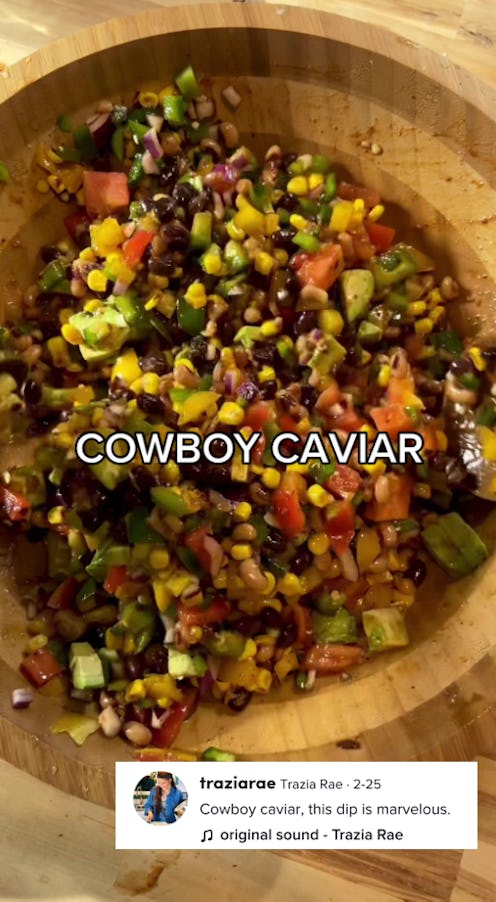Food
Cowboy Caviar Is The Latest Recipe Trending On TikTok & Here Are The Deets
A most refreshing summer chip dip.

Per usual (in the most delicious way), there is a shiny, new recipe trending on TikTok — and this one has arrived just in time for summer evenings spent sipping frozen margaritas accompanied by a good old platter of chips and dip. Seriously though, few things are better than a salsa variant of freshly sliced veggies and zesty toppings to match. The dip in question, you ask? TikTok knows it as cowboy caviar, and critics are raving.
While the first bowl of cowboy caviar was reportedly whipped up in a Texas kitchen by Helen Corbitt, the director of food services at Neiman Marcus in the early 1900s, the scoop-worthy dip has recently made a comeback on TikTok. With the hashtag #CowboyCaviar amassing over 1.2 million views, users everywhere are posting their takes on the recipe that is also known as “Texas caviar” or “summer salad.”
The foundation is always a mix of peppers, corn, beans, diced tomatoes, and onions, topped off with your choice of light dressing and seasoning, but there are endless ways to make it your own. After TikTok chef @traziarae posted a video prepping the dip on Feb. 25, users gradually started to test it out for themselves. Foodie @brialem added mango and feta cheese to her cowboy caviar, while @macy.blackwell used Italian dressing for her main source of seasoning.
What Is Cowboy Caviar?
Essentially, cowboy caviar is a chunky, flavor-packed chip dip. You can eat it with your all-time favorite tortilla chip, with a salad, by the spoonful (or two), or even as a topping for tacos. You could take dip a step further by creating a cowboy caviar avocado toast, because of course. Regardless of how exactly you choose to make it, the basics of this recipe include a wholesome smattering of onion, tomato, corn, black-eyed peas, beans, bell peppers, jalapeño, and a selection of savory seasonings.
How To Make Cowboy Caviar At Home
Following the recipe posted by Trazia Rae, whose Feb. 25 TikTok racked up 6.7 million views, whipping up cowboy caviar at home is a full-on experience that will a) boost your chopping skills and b) give you enough of the stuff to incorporate into other meals for days. (Or you can just eat it on its own if that’s your jam.) Here’s what you’ll need:
Cowboy Caviar Ingredients
- 1 purple onion, diced
- 1 tomato, diced
- 1 yellow bell pepper, diced
- 1 green bell pepper, diced
- 1 jalapeño, chopped
- 1 lime
- 1 can of corn
- 1 can of black-eyed peas
- 1 can of black beans, drained and rinsed
- 1/2 cup of olive oil
- 1/4 cup of apple cider vinegar
- 1 spoonful of sugar
- Dash of garlic powder
- Dash of chili powder
- Dash of cumin
- Dash of Aleppo pepper
- Salt and pepper, to taste
- Avocado (optional)
Process
- After gathering your veggies, give them a thorough wash before chopping.
- On a large cutting board, chop your onion, tomato, peppers, avocado (optional), and lime. Then, set aside.
- In a large bowl, toss in the corn, black-eyed peas, black beans, onion, tomato, and peppers.
- Pour in the olive oil, apple cider vinegar, and lime juice.
- Add in the sugar, garlic powder, chili powder, cumin, Aleppo pepper, salt, and pepper to taste.
- Mix everything up before topping off with the optional avocado. After adding the avo, give the dip another gentle mix and enjoy. (Scroll back to the top for a video of this recipe.)
How Long Does Cowboy Caviar Last In The Fridge?
According to Trazia Rae, one batch of cowboy caviar will last in the fridge for up to four days. The avocado makes a big difference though, so if you’re using avo in your batch, it will only be good for up to two days as the fruit browns. Just keep this magic dip covered in plastic wrap and try to use it in as many meals as you can while supplies last. TBH, this shouldn’t be too much of a challenge since yes, it really is that good.
This article was originally published on